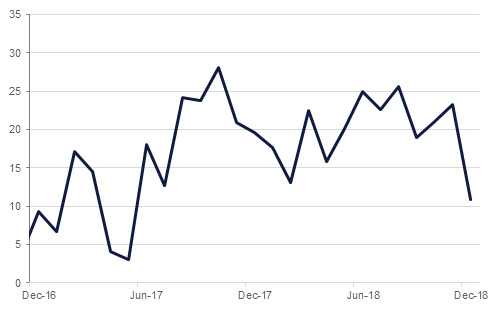.jpg?h=457&w=800&la=en&hash=B3D23E74055B6BB0893BC1002534B8BF)
The parliamentary ‘meaningful vote’ on the UK’s Brexit deal has been re-tabled by Prime Minister Theresa May for the week of January 14. She had previously cancelled the vote last week amid indications that it was unwinnable. This gives the PM more time to try and glean enough concessions and assurances on the backstop issue from Europe to placate sufficient UK lawmakers for the deal to pass. As May continues to remind them, with the clock running down, the alternative to her deal is increasingly likely to be a no-deal as she dispelled talks of a series of parliamentary votes on different options. Amid this, the opposition Labour party proposed a no-confidence motion in May, but has not done so in the government, meaning that even if it passed it would not trigger a general election.
The US FOMC begins its December meeting today, with its decision on the Fed funds rate set to be announced tomorrow. While the market-implied probability of a hike to an upper bound of 2.5% remains high, it has fallen from over 70% at the close of last week to 64.9% as the meeting begins. What will be of primary interest will be the language in the communiqué, and what signals are given with regards rates in 2019. At the last meeting, chair Jerome Powell said that the policy rate was ‘just below neutral’, and since then we have had an equities sell-off and indications in jobs and housing data that the growth cycle is nearing its peak. Complicating the matter further is vocal interference from US President Donald Trump, who has once again been tweeting his disagreement over the tightening policy.
Uncertainties regarding the US economy were highlighted by the New York Fed’s Empire State Manufacturing Index data released yesterday, which plummeted to 10.9 in December from 23.3 last month. Consensus expectations had been for a score of 20.0.
Although firms remained comparatively sanguine about next year, this is indicative of a fairly volatile business environment at the close of 2018.
 Source: Bloomberg, Emirates NBD Research
Source: Bloomberg, Emirates NBD Research
US treasury yields were little changed ahead of the start of the FOMC meeting. Yields on the 10yr UST are holding around 2.89% while the 2yr is at 2.73% and the spread maintains slightly below 16bps. The continuing sell off in equity markets will raise investor concern about the Fed’s outlook for 2019 and whether they will downgrade their dot plot and economic projections.
Moody’s revised its outlook on Bahrain’s sovereign rating to stable from negative citing the financial assistance from its GCC partners to help shore up the country’s fiscal and external accounts. Moody’s affirmed the B2 rating on the sovereign. Elsewhere the agency changed its outlook on Bank Audi, Blom Bank and Byblos Bank (all in Lebanon) to negative from stable and affirmed their ratings.
Amid a decline in equities and risk aversion sentiment in the market, JPY was Monday’s strongest performing major currency, with USDJPY falling by 0.49% to close at 112.83. This close below the 50-day moving average (113.00) is technically significant and signals that more losses may lie ahead for USDJPY. Currently USDJPY is down an additional 0.26% this morning and is likely to test the 100-day moving average (112.40), a break and daily close below which could catalyse a more significant decline to 111.
This morning’s outperformer is the NZD, which has gained on all the other majors in the aftermath of economic data which showed an improvement in Business Confidence. Currently NZDUSD is trading 0.67% higher at 0.6849and has risen just above the 200-day moving average (0.6841). A close above this level could pave the way for additional gains towards the 50% one year Fibonacci retracement (0.6931).
Developed equity markets closed in a sea of red yesterday as risk aversion remained the major market theme. In the United States, the S&P500 closed 2.08% lower, while the Nasdaq posted a loss of 2.27% and the Dow Jones tumbled by 2.11%. Their European counterparts fared equally poorly with Euro Stoxx losing 0.94%, while the DAX declined by 0.86% and the FTSE retreated 1.05%. Regional equity markets had slightly better results with the DMF rising 0.7%, the ADX rising 0.7% and the Saudi Tadawul leading the pack with the 0.8% gain.
This morning, Asian equity markets find themselves under pressure. As we go to print, the Nikkei is 1.23% lower, while the Shanghai Composite is 1.03% lower.
Oil markets were caught up in another wave of risk off selling to start the week with Brent and WTI breaking below their psychological handles of USD 60/b and USD 50/b respectively. It was WTI’s first close below USD 50/b since October 2017. The EIA estimates that shale production will top 8m b/d by the end of the year, accounting for the bulk of US crude production.
Russia’s oil production hit a record high of 11.42m b/d in December according to press reports. Russia is part of the OPEC+ decision to cut production from the start of 2019 but its cuts are expected to come in a phased manner.
Click here to Download Full article